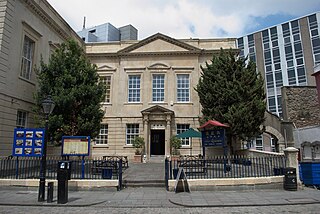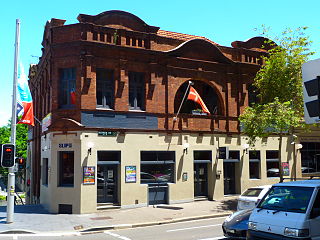
Bristol Temple Meads is the oldest and largest railway station in Bristol, England. It is located 118 miles 31 chains away from London Paddington. It is an important transport hub for public transport in the city; there are bus services to many parts of the city and surrounding districts, with a ferry to the city centre. Bristol's other major station, Bristol Parkway, is a more recent station on the northern outskirts of the conurbation. It is the busiest station in South West England.

The Church of St Mary the Virgin, widely known as St Mary Redcliffe, is the main Church of England parish church for the Redcliffe district of the city of Bristol, England. The first reference to a church on the site appears in 1158, with the present building dating from 1185 to 1872. The church is considered one of the country's finest and largest parish churches as well as an outstanding example of English Gothic architecture. The church is so large it is sometimes mistaken for Bristol Cathedral by tourists. The building has Grade I listed status, the highest possible category, by Historic England.

Bristol Cathedral, formally the Cathedral Church of the Holy and Undivided Trinity, is a Church of England cathedral in the city of Bristol, England. It is the seat of the Bishop of Bristol. The cathedral was originally an abbey dedicated to St Augustine, founded in 1140 and consecrated in 1148. It became the cathedral of the new diocese of Bristol in 1542, after the dissolution of the monasteries. It is a Grade I listed building.

Clifton College is a public school in the city of Bristol in South West England, founded in 1862 and offering both boarding and day school for pupils aged 13–18. In its early years, unlike most contemporary public schools, it emphasised science rather than classics in the curriculum, and was less concerned with social elitism, for example by admitting day-boys on equal terms and providing a dedicated boarding house for Jewish boys, called Polack's House. Having linked its General Studies classes with Badminton School, it admitted girls to every year group in 1987, and was the first of the traditional boys' public schools to become fully coeducational. Polack's House closed in 2005 but a scholarship fund open to Jewish candidates still exists. Clifton College is one of the original 26 English public schools as defined by the Public Schools Yearbook of 1889.

St James's Square is the only square in the St James's district of the City of Westminster and is a garden square. It has predominantly Georgian and Neo-Georgian architecture. For its first two hundred or so years it was one of the three or four most fashionable residential streets in London. It now has headquarters of a number of well-known businesses, including BP and Rio Tinto Group; four private members' clubs, the East India Club, the Naval and Military Club, the Canning Club, and the Army and Navy Club; the High Commission of Cyprus; the London Library; and global think tank and peace-promoter Chatham House.

Edward Colston was an English merchant, slave trader, philanthropist, and Tory Member of Parliament.

Bristol, the largest city in South West England, has an eclectic combination of architectural styles, ranging from the medieval to 20th century brutalism and beyond. During the mid-19th century, Bristol Byzantine, an architectural style unique to the city, was developed, and several examples have survived.

Castle Park is a public open space in Bristol, England, managed by Bristol City Council. It is bounded by the Floating Harbour and Castle Street to the south, Lower Castle Street to the east, and Broad Weir, Newgate and Wine Street to the north. Its western boundary is less obviously defined and has been the subject of controversy, perhaps because the area around High Street and St Mary le Port Church, though not part of the park and always intended for development, is often considered at the same time as the park.

The Bristol Crown Court is a Crown Court venue which deals with criminal cases at Small Street in Bristol, England. The building, which was completed in 1868, was previously used as a main post office before it was converted for judicial use in the early 1990s.

Queen Square is a 2.4 hectares Georgian square in the centre of Bristol, England. Following the 1831 riot, Queen Square declined through the latter part of the 19th century, was threatened with a main line railway station, but then bisected by a dual carriageway in the 1930s. By 1991 20,000 vehicles including scheduled buses were crossing the square every day, and over 30% of the buildings around it were vacant.

King Street is a 17th-century street in the historic city centre of Bristol, England.

The Great Gatehouse, also known as the Abbey Gatehouse, is a historic building on the south side of College Green in Bristol, England. Its earliest parts date back to around 1170. It was the gatehouse for St Augustine's Abbey, which was the precursor of Bristol Cathedral. The gatehouse stands to the cathedral's west, and to its own west it is abutted by the Bristol Central Library building. The library's architectural design incorporated many of the gatehouse's features.

The King William Ale House is a historic public house situated on King Street in Bristol, England. It dates from 1670 and was originally part of a row of three houses. The three have been designated by English Heritage as a grade II* listed building since 8 January 1959. It includes a mixture of 17th-century and 18th-century features, is terracotta coloured, but currently serves as a public house owned and operated by Samuel Smith Old Brewery.

St Mary the Virgin is a Church of England parish church in Henbury, Bristol, England.

The Old Library is a historic building on the north side of King Street, Bristol, England. It was built in 1738–40 and has been designated by English Heritage as a grade II* listed building.

Greyfriars, in Bristol, England, was a Franciscan friary. The name Greyfriars derived from the grey robes worn by the friars. It was founded at some time before 1234, within the town walls and then moved to Lewin's Mead in 1250. The site included extensive gardens surrounded by a stone wall. Following the Dissolution of the Monasteries in the sixteenth century, the premises were leased to the town council in 1541, who desired to use the stone to make repairs to the town walls, and the harbour facilities. In succeeding centuries many different uses have been made of the site, which is currently occupied by an office block and part of Bristol Dental School.
Pontypridd Urban District Council Tramways operated a tramway service in Pontypridd between 1904 and 1931. Part of it used the route of the Pontypridd and Rhondda Valley Tramway Company's horse tramway. Between 1919 and 1927, it was the only system in Wales where through running onto a neighbouring system occurred. In 1930, part of the system was converted to use trolleybuses, and the former horse tramway section was replaced by motor buses in 1931, bringing the tramway era to an end. During the Second World War, a number of trolleybuses were borrowed from other systems, to cope with heavy traffic, but the use of electric vehicles ended in 1957. Most of the vehicles were sold on to other undertakings, and the system was the last in Britain to be run by an Urban District Council.

The GIO Building is a heritage-listed office tower located at 60-70 Elizabeth Street in the Sydney central business district, New South Wales, Australia. It was built during 1929. It is also known as the General Insurance Office Building; the GIO building, and was constructed as the Sun Building or the Sun Newspaper Building. The property is privately owned and was added to the New South Wales State Heritage Register on 2 April 1999.

Royal George Hotel is a heritage-listed pub located at 115–117 Sussex Street, in the Sydney central business district, in the City of Sydney local government area of New South Wales, Australia. It was built in 1903. The adjoining former Cuthbert's Patent Slip building, assumed to date from 1869 and also heritage-listed, has also been incorporated into the hotel complex in recent decades. The hotel now operates as the Slip Inn. It was added to the New South Wales State Heritage Register on 2 April 1999.

National House is a heritage-listed former warehouse and bank branch and now pub located at 75 York Street, on the corner of King Street, in the Sydney central business district, in the City of Sydney local government area of New South Wales, Australia. It now operates as the Hotel CBD. It was added to the New South Wales State Heritage Register on 2 April 1999.





















